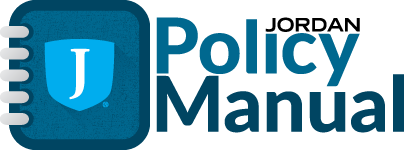- Effective: 3/26/2020
- Board Directive
The Board recognizes that unique situations create circumstances where teachers will need to be hired and qualified for positions using Local Educational Agency (LEA)-specific licenses. The Board delegates to the Administration the responsibility for implementing policy for LEA-specific licenses in accordance with Utah State Board of Education (USBE) Rule R277-301. - Administrative Policy
- Educator License and Endorsement Requirements
- Jordan LEA License Eligibility Criteria
All applicants must:- Complete a bachelor's or higher degree in a related field of study; or
- Have exceptional or specialized occupational experience, training, or expertise directly related to the area of assignment; and,
- Complete a criminal background check including review of any criminal offenses and clearance in accordance with Rule R277-214; and,
- Complete the educator ethics review described in Rule R277-500 within one calendar year prior to the application.
- Jordan LEA Endorsement Eligibility
This authorization may be issued for a one to three-year period upon request from a District administrator for a licensed teacher (LEA, Associate, or Professional) who is not endorsed in the area of assignment.
- Jordan LEA License Eligibility Criteria
- Jordan LEA License or Endorsement Approval
- The application must receive approval from the Jordan Board of Education in a public meeting no more than 60 days prior to employment and include:
- Rationale for the appointment of a Jordan LEA-specific license or endorsement.
- Verification that there is an inadequate supply of highly qualified and suitable licensed applicants in the license and endorsement area as demonstrated by posting the position for a reasonable period of not less than five days (not required for hourly applicants).
- The application must receive approval from the Jordan Board of Education in a public meeting no more than 60 days prior to employment and include:
- Applicants placed on Jordan LEA-specific licenses serve under temporary employment agreements.
- A Jordan LEA-specific license area or endorsement is valid for up to three years. After three years, renewal of the license is subject to the approval or denial of the Utah State Board of Education.
- A Jordan LEA-specific license expires immediately if the educator's employment with Jordan School District ends and the educator is not rehired by the District as an educator in the next contract year.
- The District is not authorized to provide an LEA-specific educator license in the areas of:
- Special Education
- Preschool Special Education
- Educator License and Endorsement Requirements
- The Jordan LEA-specific Educator Training, Mentoring, and Support
- Within the first year of employment, the educator must complete the following training:
- Educator ethics;
- Classroom management and instruction;
- Basic special education law and instruction; and
- Utah Effective Teaching Standards described in R277-530.
- The educator must participate in the District’s Mentoring Program.
- The District shall provide at least a three-year mentoring program by a trained mentor educator who:
- Holds a professional educator license; and
- Where possible, performs substantially the same duties as the educator with release time to work as a mentor; or
- Is assigned as an instructional coach or equivalent position.
- The assigned mentor shall assist the educator to meet the Utah Effective Educator Standards established in Rule R277-530 but may not serve as an evaluator of the educator.
- All employees, to include mentors, must promptly report educator misconduct in violation of policy DP378 Employee Code of Conduct.
- The Applicant and the District will jointly develop an Associate Licensing Plan to:
- Encourage transition from a Jordan LEA License to a Professional License.
- Identify applicable educational, skill, and/or content knowledge requirements for enrollment in a qualified educator preparation program.
- Identify paths and opportunities to prepare for successful passage of a pedagogical performance assessment.
- Develop significant competency and knowledge sufficient to justify an extension request from the Utah State Board of Education for a continued Jordan LEA License if transition to an Associate License is not reasonable or applicable.
- For each school that requests LEA-specific licenses, license areas, or endorsements, the following information shall be posted on its website:
- Disclosure of the fact that the school employs individuals holding LEA-specific educator licenses, license areas, or endorsements
- Percentage of LEA-specific licenses, license areas, or endorsements
- A link to the Utah State Board of Education Utah Educator Look-up Tool in accordance with R277-515-7(6)
- Within the first year of employment, the educator must complete the following training:
